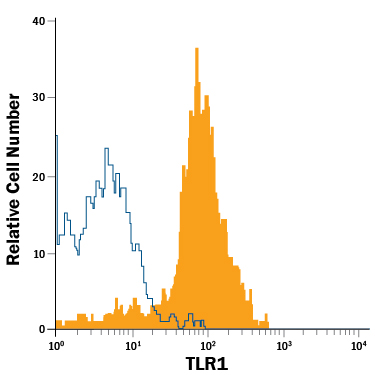Human TLR1 APC-conjugated Antibody Summary
Ser22-Asn578
Accession # AAC34137
Applications
Please Note: Optimal dilutions should be determined by each laboratory for each application. General Protocols are available in the Technical Information section on our website.
Scientific Data
 View Larger
View Larger
Detection of TLR1 in Human Monocytes by Flow Cytometry. Human monocytes were stained with Goat Anti-Human TLR1 APC-conjugated Antigen Affinity-purified Polyclonal Antibody (Catalog # FAB1484A, filled histogram) or isotype control antibody (Catalog # IC108A, open histogram). View our protocol for Staining Membrane-associated Proteins.
Reconstitution Calculator
Preparation and Storage
Background: TLR1
The Toll-like family of molecules are type I transmembrane proteins that serve as pattern recognition receptors for microbial pathogens. There are at least eleven mouse and ten human TLRs that activate the innate immune system following exposure to a variety of microbial species (1, 2). TLRs contain a large number of leucine-rich repeats (LRRs) and a cytoplasmic tail with one Toll/IL-1 receptor (TIR) domain. Mature human TLR1 consists of a 556 amino acid (aa) extracellular domain (ECD) with 20 LRRs, a 21 aa transmembrane segment, and a 185 aa cytoplasmic domain (3, 4). Within the ECD, human TLR1 shares 63% aa sequence identity with human TLR6 and 20%‑43% aa sequence identitity with human TLR2, -3, -4, -5, -7, -8, -9, and -10. It shares 73% and 71% aa sequence identity with mouse and rat TLR1, respectively. TLR1 is expressed on the surface of macrophages, dendritic cells, and tonsillar epithelial cells in ligand-independent association with TLR2 (5‑8). TLR2 additionally associates with TLR6 to form a functional complex with specificity for distinct but related microbial ligands (9‑11). TLR1 and TLR2 cooperate in the recognition of bacterial and protozoal triacylated lipopeptides and glycosylphosphatidylinositols (6, 10‑12). Ligand binding induces TLR1 localization to lipid rafts followed by receptor internalization and activation of NF kappa B (7, 11, 13).
- Miyake, K. (2007) Semin. Immunol. 19:3.
- Hopkins, P.A. and S. Sriskandan (2005) Clin. Exp. Immunol. 140:395.
- Rock, F.L. et al. (1998) Proc. Natl. Acad. Sci. 95:588.
- Matsushima, N. et al. (2007) BMC Genomics 8:124.
- Ochoa, M.-T. et al. (2003) Immunology 108:10.
- Takeuchi, O. et al. (2002) J. Immunol. 169:10.
- Triantafilou, M. et al. (2006) J. Biol. Chem. 281:31002.
- Sandor, F. et al. (2003) J. Cell Biol. 162:1099.
- Nakao, Y. et al. (2005) J. Immunol. 174:1566.
- Ozinsky, A. et al. (2000) Proc. Natl. Acad. Sci. 97:13766.
- Lee, J.Y. et al. (2004) J. Biol. Chem. 279:16971.
- Krishnegowda, G. et al. (2005) J. Biol. Chem. 280:8606.
- Nishiya, T. and A.L. DeFranco (2004) J. Biol. Chem. 279:19008.
Product Datasheets
Citation for Human TLR1 APC-conjugated Antibody
R&D Systems personnel manually curate a database that contains references using R&D Systems products. The data collected includes not only links to publications in PubMed, but also provides information about sample types, species, and experimental conditions.
1 Citation: Showing 1 - 1
-
A Common Genetic Variant in TLR1 Enhances Human Neutrophil Priming and Impacts Length of Intensive Care Stay in Pediatric Sepsis.
Authors: Whitmore L, Hook J, Philiph A, Hilkin B, Bing X, Ahn C, Wong H, Ferguson P, Moreland J
J Immunol, 2016-01-04;196(3):1376-86.
Species: Human
Sample Types: Whole Cells
Applications: Flow Cytometry
FAQs
No product specific FAQs exist for this product, however you may
View all Antibody FAQsReviews for Human TLR1 APC-conjugated Antibody
There are currently no reviews for this product. Be the first to review Human TLR1 APC-conjugated Antibody and earn rewards!
Have you used Human TLR1 APC-conjugated Antibody?
Submit a review and receive an Amazon gift card.
$25/€18/£15/$25CAN/¥75 Yuan/¥2500 Yen for a review with an image
$10/€7/£6/$10 CAD/¥70 Yuan/¥1110 Yen for a review without an image







